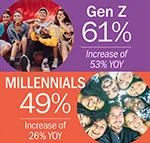 Megan Mills Megan Mills |
When I was growing up, dinnertime was a part of my family’s daily routine. It offered a regular opportunity for five busy people to connect and catch up on the news of the day.
Dinnertime was a flexible concept that transformed as our family’s needs, finances and priorities changed. Sometimes it was home-made spaghetti and meatballs eaten around the kitchen table, and other times it was pre-made sandwiches eaten in the car on the way to rehearsal. But whatever the menu or where the meal was served, this important evening meal always provided the nutritional and emotional sustenance we needed.
Dinnertime was a core component of my childhood and remains a key component of my family life today, so it’s no surprise that it also provides me with valuable lessons for communications planning. From developing nutrition education campaigns to tapping into stakeholder-led social media initiatives about food safety, here are four ways family meal planning can help communicators shape campaigns to meet the diverse needs—and preferences—of consumers.
Don’t guess who’s coming to dinner. Understanding who’s at the table is the first step in creating a successful meal. It determines not just what to cook, but how much to cook, and sometimes even how to prepare it. You don’t want to be the person who serves PB&J to someone with a peanut allergy, and if you prepare a family feast for just two, you’ll be eating leftovers for days. In the context of communications, understanding who you’re trying to reach and how they prefer to receive this information is crucial to creating an effective campaign.
| This article is featured in O'Dwyer's Mar. '24 Food & Beverage PR Magazine (view PDF version) |
For example, we know that lower levels of nutrition label numeracy are associated with older age, Black and Hispanic race/ethnicity, unemployment, lower English proficiency, lower education achievement and lower income. Additionally, we know these same audiences are at greater risk for nutrition-related chronic diseases. But just because these different audiences need educational resources to address that risk, doesn’t mean we can reach them in the same way.
Each of these groups can have vastly different attitudinal, behavioral and socioeconomic factors, demographics, barriers and motivators, health statuses and media consumption habits, and a one-size-fits-all approach could mean you end up with a “feast” of resources that no one is consuming.
As a parent, I’m innately familiar with my family’s needs, but to understand more about who we’re trying to reach with a communications campaign we need to do some research. When you’re planning a communications campaign, think about conducting focus groups, in-depth interviews or social-listening exercises. These kinds of activities will help you understand lifestyle and attitudinal factors, existing behaviors, challenges and barriers to desired behaviors, messaging strategies, preferred media channels and other creative considerations to consider when creating resources or outreach activities that help consumers make informed decisions about food.
Plan ahead. Meal planning is the key to success in my house. It’s my roadmap for the week. It helps inform my grocery list, saves time and money, helps us reduce food waste and often leads to healthier food choices for all five of us. Most importantly though, it means I’ve always got an answer when someone inevitably asks that age-old question: “What’s for dinner?”
Similarly, developing a communications plan is an essential component of every communications campaign. Like a meal plan, a strategic communications plan serves as a roadmap for the team to navigate and optimize communication efforts. Your plan should outline goals, key messages and the action you’ll take to effectively convey important nutrition information. This is especially important when messages need to be relevant and exciting as well as simple, accurate and scientific.
Understand what you want to accomplish with the meal. Dinnertime looks different for everyone. Now that we’re adults, my siblings and I have diverse dinner styles because our meals have very different purposes beyond basic nourishment. For example, my older sister wants her last meal of the day to help her relax and unwind, so she’ll make something small that won’t keep her up late at night. On the other hand, my active family of five needs a large meal that will fuel growing kids during long sports practices and late-night study sessions.
Understanding what you need to accomplish with each meal helps inform the menu, manage expectations and assess how each meal is meeting the needs of the diners. Communications campaigns aren’t any different. Nutrition campaigns can have a wide range of goals and objectives from promoting healthy behaviors to educating individuals and communities about the science of nutrition to increasing awareness of food security issues.
Clearly defining the goals and objectives of your campaign sets expectations, helps everyone understand the rationale behind your recommendations and provides a measure against which to track progress. Consider incorporating well-defined, measurable objectives that are innovative, actionable, cost-effective and reflective of your formative research.
Be nimble in your planning. Sometimes dinner doesn’t look like you imagined. It’s good to have a plan, but it’s also important to understand how and when to adjust. If tryouts are canceled because of bad weather or if someone had an unexpectedly long day at the office, I assess our new needs and revise my plan for the meal. This might mean doing something as simple as incorporating a few pre-prepared items, or it could mean taking a whole new approach and stopping for a fast-food meal on the way home.
When executing a nutrition education campaign, this might look like including a unique evaluation strategy in your campaign plan. This gives you the chance to consistently gather the information you need to improve your campaign. For example, if you include a process evaluation that assesses how well stakeholder outreach tactics or specific paid media channels are performing, your findings will allow for course corrections as necessary throughout the campaign, ensuring progress on various levels of engagement, from awareness and knowledge to interest, support and action.
Creating an effective communications campaign that encourages healthy behaviors doesn’t have to be complicated. By approaching communications like we approach preparing dinner for family or friends, we can create innovative nutrition communications campaigns that resonate with communities and individuals.
***
Megan Mills is a Senior Account Supervisor at Hager Sharp.


 Tips to refine and amplify your CPG brand strategy to win in 2024 and beyond.
Tips to refine and amplify your CPG brand strategy to win in 2024 and beyond. Strategic communications strategies for success in the growing “food is medicine” movement.
Strategic communications strategies for success in the growing “food is medicine” movement. How brands can authentically communicate sustainability issues and create a brand experience that’s compatible with consumers’ values.
How brands can authentically communicate sustainability issues and create a brand experience that’s compatible with consumers’ values. Communicating the effects that climate change and a growing world population have on our food system—and why change is needed.
Communicating the effects that climate change and a growing world population have on our food system—and why change is needed. More younger Americans are abstaining from alcohol, according to recent research on the growing sober-curious movement, presenting a challenge—and an opportunity—for beverage marketers in 2024.
More younger Americans are abstaining from alcohol, according to recent research on the growing sober-curious movement, presenting a challenge—and an opportunity—for beverage marketers in 2024.


 Have a comment? Send it to
Have a comment? Send it to 
No comments have been submitted for this story yet.